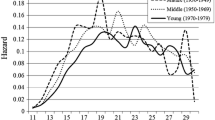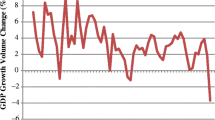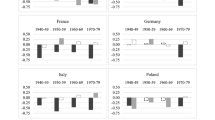Abstract
Although advanced education has been found to be consistently associated with a later transition to parenthood for women, findings about education and the transition to parenthood have been much less consistent for men, and no stylized fact has emerged from the literature. We argue that the inconsistency of findings for men is due to the fact that the selection process involved in union formation has been disregarded in earlier studies. We hypothesize that men’s educational attainment consistently and positively affects the transition to fatherhood via higher rates of union formation. We apply multiprocess event-history analysis to data from the Generations and Gender Surveys for 10 European countries. Our results show indeed a consistent positive effect of education on the transition to fatherhood, but it operates chiefly through selection into union. Failing to account for this selection process leads to a major underestimation of the salience of education for the transition to fatherhood.



Similar content being viewed by others
Notes
We excluded Russia and Georgia because of the very different cultural and institutional backgrounds of these countries. The data for the Czech Republic were not available when we were conducting our analyses.
The higher limit of this birth cohort differs among countries: 1983 (Estonia, Hungary); 1988 (Norway); 1989 (Lithuania); 1990 (Austria, Belgium); and 1993 (Poland).
References
Aassve, A., Billari, F. C., Michielin, F., & Panis, C. (2003). A Monte Carlo study of (simultaneous) hazard models with flexible baseline and normally distributed error terms (Studi Demografici Working Paper No.14). Milan, Italy: Istituto di Metodi Quantitativi, Università L. Bocconi.
Alich, D. (2009). Fatherhood in Russia between 1970 and 2004: The male perspective of family and fertility behavior in a changing society (Unpublished doctoral dissertation). University of Rostock, Rostock, Germany.
Baizán, P., Aassve, A., & Billari, F. (2003). Cohabitation, marriage, and first birth: The interrelationship of family formation events in Spain. European Journal of Population, 19, 147–169.
Becker, G. S. (1991). A treatise on the family. Cambridge, MA: Harvard University Press.
Begall, K. (2013). How do educational and occupational resources relate to the timing of family formation? A couple analysis of the Netherlands. Demographic Research, 29(article 34), 907–936. doi:10.4054/DemRes.2013.29.34
Berrington, A. M., Hernández, M. I. C., Ingham, R., & Stevenson, J. (2005). Antecedents and outcomes of young fatherhood: Longitudinal evidence from the 1970 British Birth Cohort Study (Applications & Policy Working Paper A05/09). Southampton, UK: Southampton Statistical Sciences Research Institute.
Billari, F. C., & Liefbroer, A. C. (2007). Should I stay or should I go? The impact of age norms on leaving home. Demography, 44, 181–198.
Blossfeld, H.-P., Golsch, K., & Rohwer, G. (2007). Event history analysis with Stata. Mahwah, NJ: Erlbaum Associates.
Blossfeld, H.-P., & Huinink, J. (1991). Human capital investments or norms of role transition? How women’s schooling and career affect the process of family formation. American Journal of Sociology, 97, 143–168.
Brien, M. J., Lillard, L. A., & Waite, L. J. (1999). Interrelated family-building behaviors: Cohabitation, marriage, and non-marital conception. Demography, 36, 535–551.
Carlson, M. J., VanOrman, A. G., & Pilkauskas, N. V. (2013). Examining the antecedents of U.S. nonmarital fatherhood. Demography, 50, 1421–1447.
Cherlin, A. J. (2010). Demographic trends in the United States: A review of research in the 2000s. Journal of Marriage and Family, 72, 403–419.
Coltrane, S. (2000). Research on household labor: Modeling and measuring the social embeddedness of routine family work. Journal of Marriage and Family, 62, 1208–1233.
Corijn, M., & Klijzing, E. (Eds.). (2001). Transition to adulthood in Europe (European Studies of Population Series, Vol. 10). Dordrecht, The Netherlands: Kluwer Publishers.
Corijn, M., Liefbroer, A., & de Gierveld, J. J. (1996). It takes two to tango, doesn’t it? The influence of couple characteristics on the timing of the birth of the first child. Journal of Marriage and Family, 58, 117–126.
Craig, L., & Mullan, K. (2010). Parenthood, gender and work-family time in the United States, Australia, Italy, France, and Denmark. Journal of Marriage and Family, 72, 1344–1361.
Craig, L., & Mullan, K. (2011). How mothers and fathers share childcare: A cross-national time-use comparison. American Sociological Review, 76, 834–861.
De Hauw, Y., Grow, A., & Van Bavel, J. (2015, April–May). The reversal of gender inequality in education and assortative mating in Europe. Paper presented at the Annual Meeting of the Population Association of America, San Diego, CA.
DiPrete, T. A., & Buchmann, C. (2006). Gender-specific trends in the value of education and the emerging gender gap in college completion. Demography, 43, 1–24.
Eggebeen, D. J., & Knoester, C. (2001). Does fatherhood matter for men? Journal of Marriage and Family, 63, 381–393.
England, P. (2010). The gender revolution: Uneven and stalled. Gender & Society, 24, 149–166.
Esteve, A., García-Roman, J., & Permanyer, I. (2012). The gender-gap reversal in education and its effect on union formation: The end of hypergamy? Population and Development Review, 38, 535–546.
Fokkema, T., Kveder, A., Hiekel, N., Emery, T., & Liefbroer, A. C. (2016). Generations and Gender Programme Wave 1 data collection: An overview and assessment of sampling and fieldwork methods, weighting procedures, and cross-sectional representativeness. Demographic Research, 34(article 18), 499–524. doi:10.4054/DemRes.2016.34.18
Goldscheider, F., Bernhardt, E., & Lappegard, T. (2014). Studies of men’s involvement in the family—Part 1: Introduction. Journal of Family Issues, 35, 995–999.
Goldscheider, F., & Kaufman, G. (1996). Fertility and commitment: Bringing men back in. Population and Development Review, 22, 87–99.
Goldscheider, F., & Waite, L. (1986). Sex differences in the entry into marriage. American Journal of Sociology, 92, 91–109.
Grow, A., & Van Bavel, J. (2015). Assortative mating and the reversal of gender inequality in education in Europe: An agent-based model. PloS One, 10(6), e0127806. doi:10.1371/journal.pone.0127806
Gustafsson, S., & Worku, S. (2006). Assortative mating by education and postponement of couple formation and first birth in Britain and Sweden. In S. Gustafsson & A. Kalwij (Eds.), Education and postponement of maternity: Economic analysis for industrialized countries (pp. 259–284). Dordrecht, The Netherlands: Springer.
Huinink, J., & Kohli, M. (2014). A life-course approach to fertility. Demographic Research, 30(article 45), 1293–1326. doi:10.4054/DemRes.2014.30.45
Jalovaara, M. (2011). Socioeconomic resources and the dissolution of cohabitations and marriages. European Journal of Population, 2, 167–193.
Jalovaara, M. (2012). Socio-economic resources and first-union formation in Finland, cohorts born 1969–81. Population Studies, 66, 69–85.
Jalovaara, M., & Miettinen, A. (2013). Does his paycheck also matter? Demographic Research, 28(article 31), 881–916. doi:10.4054/DemRes.2013.28.31
Joyner, K., Peters, H. E., Hynes, K., Sikora, A., Taber, J. R., & Rendall, M. S. (2012). The quality of male fertility data in major U.S. surveys. Demography, 49, 101–124.
Kalmijn, M. (2011). The influence of men’s income and employment on marriage and cohabitation: Testing Oppenheimer’s theory in Europe. European Journal of Population, 27, 269–293.
Kalmijn, M. (2013). The educational gradient in marriage: A comparison of 25 European countries. Demography, 50, 1499–1520.
Klesment, M., & Van Bavel, J. (2015). The reversal of the gender gap in education and female breadwinners in Europe (Families And Societies Working Paper No. 26). Stockholm, Sweden: Stockholm University, Department of Sociology.
Kravdal, Ø. (2007). Effects of current education on second- and third-birth rates among Norwegian women and men born in 1964: Substantive interpretations and methodological issues. Demographic Research, 17(article 9), 211–246. doi:10.4054/DemRes.2007.17.9
Kravdal, Ø., & Rindfuss, R. (2008). Changing relationships between education and fertility: A study of women and men born 1940 to 1964. American Sociological Review, 73, 854–873.
Kreyenfeld, M., & Konietzka, D. (2008). Education and fertility in Germany. In I. Hamm, H. Seitz, & M. Werding (Eds.), Demographic change in Germany: The economic and fiscal consequences (pp. 165–188). Berlin and Heidelberg, Germany: Springer-Verlag.
Lappegård, T., & Rønsen, M. (2005). The multifaceted impact of education on entry into motherhood. European Journal of Population, 21, 31–49.
Lappegård, T., & Rønsen, M. (2013). Socioeconomic differences in multipartner fertility among Norwegian men. Demography, 50, 1135–1153.
Liefbroer, A., & Corijn, M. (1999). Who, what, where, and when? Specifying the impact of educational attainment and labor force participation on family formation. European Journal of Population, 15, 45–75.
Lillard, L. A. (1993). Simultaneous equations for hazards: Marriage duration and fertility timing. Journal of Econometrics, 56, 189–217.
Lillard, L. A., Brien, M. J., & Waite, L. J. (1995). Premarital cohabitation and subsequent marital dissolution: A matter of self-selection? Demography, 32, 437–457.
Lillard, L. A., & Panis, C. W. A. (2003). AML multilevel multiprocess statistical software (Release 2.0). Los Angeles, CA: EconWare.
Lillard, L. A., & Waite, L. J. (1993). A joint model of marital childbearing and marital disruption. Demography, 30, 653–681.
Lindberg, L. D., Sonenstein, F. L., Martinez, G., & Marcotte, J. (1998). Completeness of young fathers’ reports of fertility. Journal of Economic and Social Measurement, 24, 15–23.
Manlove, J., Ryan, S., Wildsmith, E., & Franzetta, K. (2010). The relationship context of nonmarital childbearing in the U.S. Demographic Research, 23(article 22), 615–654. doi:10.4054/DemRes.2010.23.22
Martin-Garcia, T. (2009). “Bring men back in”: A re-examination of the impact of type of education and educational enrolment on first births in Spain. European Sociological Review, 25, 199–213.
Martin-Garcia, T., & Baizan, P. (2006). The impact of the type of education and of educational enrolment on first births. European Sociological Review, 22, 259–275.
McDonald, P. (2000). Gender equity in theories of fertility transition. Population and Development Review, 26, 427–439.
Mills, M., Rindfuss, R. R., McDonald, P., & te Velde, E. (2011). Why do people postpone parenthood? Reasons and social policy incentives. Human Reproduction Update, 17, 848–860.
Murphy, M. (2013). Cross-national patterns of intergenerational continuities in childbearing in developed countries. Biodemography and Social Biology, 59, 101–126.
Oppenheimer, V. K. (1988). A theory of marriage timing. American Journal of Sociology, 94, 563–591.
Oppenheimer, V. K. (1994). Women’s rising employment and the future of the family in industrial societies. Population and Development Review, 20, 293–342.
Oppenheimer, V. K. (1997). Women’s employment and the gain to marriage: The specialization and trading model. Annual Review of Sociology, 23, 431–453.
Panis, C. W. A. (1994). The piecewise linear spline transformation with an application to age at first marriage. Stata Technical Bulletin, 18, 27–29.
Perelli-Harris, B., Kreyenfeld, M., Sigle-Rushton, W., Keizer, R., Lappegård, T., Jasilioniene, A., & Di Giulio, P. (2012). Changes in union status during the transition to parenthood in eleven European countries, 1970s to early 2000s. Population Studies, 66, 167–182.
Quintini, G., & Manfredi, T. (2009), Going separate ways? School-to-work transitions in the United States and Europe (OECD Social, Employment and Migration Working Papers, No. 90). Paris, France: OECD.
Raley, S., Bianchi, S. M., & Wang, W. (2012). When do fathers care? Mothers’ economic contribution and fathers’ involvement in child care. American Journal of Sociology, 117, 1422–1459.
Rendall, M. S., Clarke, L., Peters, H. E., Ranjit, N., & Verropoulou, G. (1999). Incomplete reporting of men’s fertility in the United States and Britain: A research note. Demography, 36, 135–144.
Schwartz, C. R., & Mare, R. D. (2005). Trends in educational assortative marriage from 1940 to 2003. Demography, 42, 621–646.
Sobotka, T. (2004). Postponement of childbearing and low fertility in Europe. Groningen/Amsterdam, The Netherlands: Rijksuniversiteit Groningen/Dutch University Press.
Sullivan, O., Billari, F. C., & Altintas, E. (2014). Fathers’ changing contributions to child care and domestic work in very low-fertility countries: The effect of education. Journal of Family Issues, 35, 1048–1065.
Sweeney, M. M. (2002). Two decades of family change: The shifting economic foundations of marriage. American Sociological Review, 67, 132–147.
Tesching, K. (2012). Education and fertility: Dynamic interrelations between women’s educational level, educational field and fertility in Sweden (Dissertation Series 6). Stockholm, Sweden: Stockholm University Demography Unit.
Thomson, E. (1997). Couple childbearing desires, intentions, and births. Demography, 34, 343–354.
Van Bavel, J. (2010). Choice of study discipline and the postponement of motherhood in Europe: The impact of expected earnings, gender composition and family attitudes. Demography, 47, 439–458.
Van Bavel, J. (2012). The reversal of gender inequality in education, union formation and fertility in Europe. Vienna Yearbook of Population Research, 10, 127–154.
Vignoli, D., Drefahl, S., & De Santis, G. (2012). Whose job instability affects the likelihood of becoming a parent in Italy? A tale of two partners. Demographic Research, 26(article 2), 41–62. doi:10.4054/DemRes.2012.26.2
Vikat, A., Spéder, Z., Beets, G., Billari, F. C., Bühler, C., Désesquelles, A., . . . Solaz, A. (2007). Generations and gender survey: Concept and design. In United Nations (Ed.), Generations and gender programme: Concepts and guidelines (pp. 3–32). Geneva, Switzerland: United Nations.
Vincent-Lancrin, S. (2008). The reversal of gender inequalities in higher education: An on-going trend. Higher education to 2013 (Vol. 1, pp. 265–298). Retrieved from https://www1.oecd.org/edu/ceri/41939699.pdf
Winkler-Dworak, M., & Toulemon, L. (2007). Gender differences in the transition to adulthood in France: Is there convergence over the recent period? European Journal of Population, 23, 273–314.
Zhang, L. (2011). Male fertility patterns and determinants (Vol. 27). Dordrecht, The Netherlands: Springer Netherlands.
Acknowledgments
The research leading to these results has received funding from the European Research Council under the European Union’s Seventh Framework Program (FP/2007-2013)/ERC Grant Agreement No. 312290 for the GENDERBALL project.
Author information
Authors and Affiliations
Corresponding author
Rights and permissions
About this article
Cite this article
Trimarchi, A., Van Bavel, J. Education and the Transition to Fatherhood: The Role of Selection Into Union. Demography 54, 119–144 (2017). https://doi.org/10.1007/s13524-016-0533-3
Published:
Issue Date:
DOI: https://doi.org/10.1007/s13524-016-0533-3




